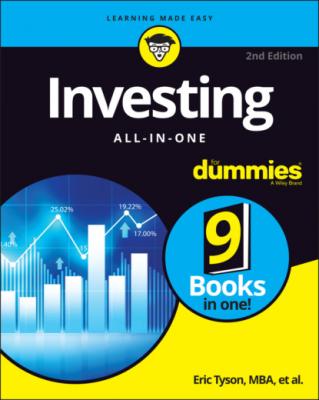Investing All-in-One For Dummies. Eric Tyson
Чтение книги онлайн.
Читать онлайн книгу Investing All-in-One For Dummies - Eric Tyson страница 49
 lower than the prior year? The death knell of many a company has been excessive debt.
lower than the prior year? The death knell of many a company has been excessive debt.
Evaluating a company’s management
The management of a company is crucial to its success. Before you buy stock in a company, you want to know that the company’s management is doing a great job. But how do you do that? If you call up a company and ask, it may not even return your phone call. How do you know whether management is running the company properly? The best way is to check the numbers. The following sections tell you the numbers you need to check. If the company’s management is running the business well, the ultimate result is a rising stock price.
Return on equity
To find out a company’s earnings, check out the company’s income statement. The income statement is a simple financial statement that expresses this equation: sales (or revenue) minus expenses equals net earnings (or net income or net profit). You can see an example of an income statement in Table 2-1. (Chapter 4 in Book 3 gives more details on income statements.)
TABLE 2-1 Grobaby, Inc., Income Statement
| 2019 Income Statement | 2020 Income Statement | |
|---|---|---|
| Sales | $82,000 | $90,000 |
| Expenses | –$75,000 | –$78,000 |
| Net earnings | $7,000 | $12,000 |
To find out a company’s equity, check out that company’s balance sheet. (See Chapter 4 in Book 3 for more details on balance sheets.) The balance sheet is actually a simple financial statement that illustrates this equation: total assets minus total liabilities equals net equity. For public stock companies, the net assets are called shareholders’ equity or simply equity. Table 2-2 shows a balance sheet for Grobaby, Inc.
TABLE 2-2 Grobaby, Inc., Balance Sheet
| Balance Sheet as of December 31, 2019 | Balance Sheet as of December 31, 2020 | |
|---|---|---|
| Total assets (TA) | $55,000 | $65,000 |
| Total liabilities (TL) | –$20,000 | –$25,000 |
| Equity (TA minus TL) | $35,000 | $40,000 |
Table 2-1 shows that Grobaby’s earnings went from $7,000 to $12,000. In Table 2-2, you can see that Grobaby increased the equity from $35,000 to $40,000 in one year. The ROE for the year 2019 is 20 percent ($7,000 in earnings divided by $35,000 in equity), which is a solid number. The following year, the ROE is 30 percent ($12,000 in earnings divided by $40,000 in equity), another solid number. A good minimum ROE is 10 percent, but 15 percent or more is preferred.
Equity and earnings growth
Two additional barometers of success are a company’s growth in earnings and growth of equity:
Look at the growth in earnings in Table 2-1. The earnings grew from $7,000 (in 2019) to $12,000 (in 2020), a percentage increase of 71 percent ($12,000 minus $7,000 equals $5,000, and $5,000 divided by $7,000 is 71 percent), which is excellent. At a minimum, earnings growth should be equal to or better than the rate of inflation, but because that’s not always a reliable number, I like at least 10 percent.
In Table 2-2, Grobaby’s equity grew by $5,000 (from $35,000 to $40,000), or 14.3 percent ($5,000 divided by $35,000), which is very good — management is doing good things here. You want to see equity increasing by 10 percent or more.
Insider buying
Noticing who’s buying and/or recommending a company’s stock
You can invest in a great company and still see its stock go nowhere. Why? Because what makes the stock go up is demand — when there’s more buying than selling of the stock. If you pick a stock for all the right reasons and the market notices the stock as well, that attention causes the stock price to climb. The things to watch for include the following:
Institutional buying: Are mutual funds and pension plans buying up the stock you’re looking at? If so, this type of buying power can exert tremendous upward pressure on the stock’s price. Some resources and publications track institutional buying and how that affects any particular stock. Frequently, when a mutual fund buys a stock, others soon follow. In spite of all the talk about independent research, a herd mentality still exists.
Analysts’